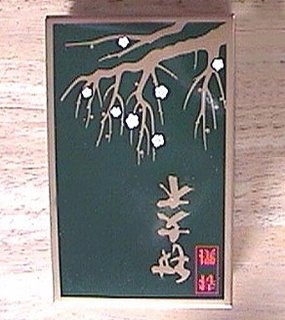 To the family, the elegant kanji on the box was like a pretty abstract picture, not actual writing. (I also heard a story once from someone in my Japanese class at university whose friend had the kanji for fire tattooed on his arm... it looked pretty cool, except that it too was upside down.)
To the family, the elegant kanji on the box was like a pretty abstract picture, not actual writing. (I also heard a story once from someone in my Japanese class at university whose friend had the kanji for fire tattooed on his arm... it looked pretty cool, except that it too was upside down.)I see the same thing happening sometimes with Sanskrit and yoga. First, some history.
Yoga (not just poses, but the whole philosophical system) has been around for at least 5000 years. But the yoga we are most familiar with was codified by a guy named Patanjali about 200 CE. (by the way, CE means "common era" and is the hip way to say AD) Patanjali wrote his text "The Yoga Sutras" in the academic language of the day, Sanskrit. (To learn more about the history of yoga click here)
It would be misleading of me to say that Sanskrit was a common tongue 2000 years ago. But from what I understand, in south-east asia it was the language of learning and religion, much like Latin in Europe. So Patanjali and most of the great philosophers wrote stuff down, including the names of the yoga poses, in Sanskrit.
So let's take a pose with its sanskrit name, for example, Paripurna Navasana. There is something very alluring about the name in its original language, the double Ps and the silky way Navasana rolls off the tongue. It's exotic, it makes you feel like something big is happening.
But let's come back down to earth and look at the Sanskrit word for word.
paripurna means "complete" or "full"
nava means "boat" asana means "pose" or "form" (in Sanskrit, there is a complete liason between vowels, so nava asana becomes navasana)
 And there you have it in plain, practical, boring English... full boat pose. It's easy to get involved in the beauty of the ancient language, but we run the risk of being a little silly, like Michiko's family gazing at upside down boxes. Face it, this pose looks like a boat! And when you do it, having the image of a boat bobbing in the water really helps. (By the way, if you ask someone doing this pose what they would like to call it, they'll tell you call it whatever you want, just let it be over!)
And there you have it in plain, practical, boring English... full boat pose. It's easy to get involved in the beauty of the ancient language, but we run the risk of being a little silly, like Michiko's family gazing at upside down boxes. Face it, this pose looks like a boat! And when you do it, having the image of a boat bobbing in the water really helps. (By the way, if you ask someone doing this pose what they would like to call it, they'll tell you call it whatever you want, just let it be over!)So, teaching yoga in Japan, I try to use Japanese names for the poses as much as possible, based on the original Sanskrit. I want my students to know that nothing exotic is happening during the poses, and to really get the idea of the form. Bhujangasana sounds really cool, but it won't get a student to press their hips into the mat like "Cobra Pose" will.
The person who really brought me around to this way of thinking is Thich Nhat Hanh. When we went to his retreat a few years ago there wasn't a word of Vietnamese or Pali the entire time. All the chants, songs, and meditations, except for "Om" were in English. And a lot of people there were dissapointed at how "ordinary" everything was. At the end of the retreat, if you took the 5 Mindfullness Precepts, you were given a dharma name in English. (My name is "Silent Breath of the Heart" and Gwen's is "Lovely Teacher of the Heart") One of the women in our group asked the monk "Can't you tell me my name with the Vietnamese version? I bet it's beautiful!" The monk smiled and explained that he could, but that he would not, and gave the argument that I have outlined above, that these names are to help us, not distract us. Now, years later, I still remember most of the chants from that retreat, because they were in English.
So, in yoga, by all means study and learn the Sanskrit, but don't be fooled into thinking that these foreign words make the practice any more exotic. For Patanjali these names were nothing special, they were just a way of describing the shape of the body. Like zen, yoga is nothing special, and once you accept that you'll really start going places!
Namaste (namas=I bow, te= to you!)
Patrick
Yoga Garden


1 comment:
Boat pose is my favorite core strengthener. I found that Leeann Carey has a great free yoga video that also shows how to do navasana with a partner. I thought your readers could benefit from taking a look at this: https://www.planetyoga.com/free-yoga-video-partner-boat-pose/
Post a Comment